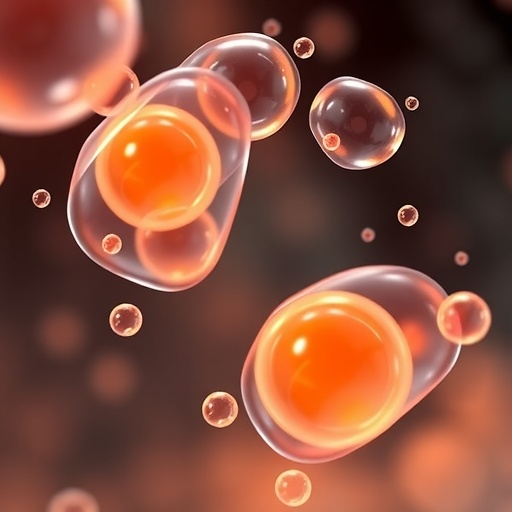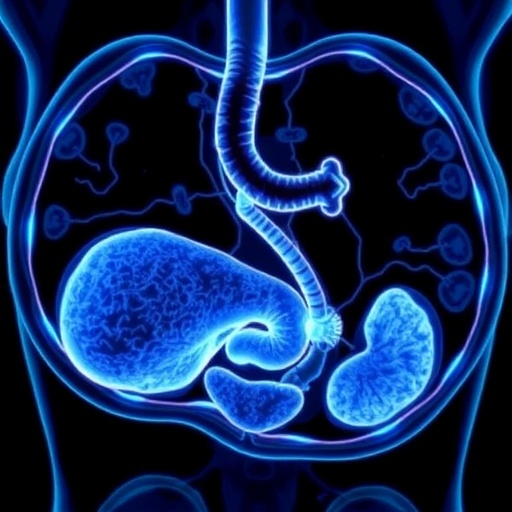In a groundbreaking advancement at the intersection of nutrition, cellular biology, and obesity management, new research highlights the powerful potential of extracellular vesicles (EVs) isolated from human breast milk in modulating metabolic processes. The study, led by Peng et al. and published in the International Journal of Obesity in 2025, reveals that specific phospholipids carried by these milk-derived EVs can trigger profound biochemical signaling pathways within adipose tissue, ultimately enhancing thermogenesis and lipolysis. This work not only deepens our understanding of maternal milk composition beyond simple nutrition but also opens novel therapeutic vistas for combating obesity at the molecular level.
Extracellular vesicles are nano-sized lipid bilayer-enclosed particles secreted by virtually all cell types, functioning as critical messengers capable of transferring bioactive molecules such as proteins, lipids, and RNA to distant cells. Human breast milk, a remarkably complex fluid, is now recognized as a rich source of such EVs. Prior studies have hinted at their role in immune modulation and infant development; however, their involvement in metabolic regulation within adults had remained largely unexplored. The current investigation zeroes in on the phospholipid content within these milk EVs, which might mediate crucial signaling pathways influencing fat metabolism.
.adsslot_O1QXSlksiv{width:728px !important;height:90px !important;}
@media(max-width:1199px){ .adsslot_O1QXSlksiv{width:468px !important;height:60px !important;}
}
@media(max-width:767px){ .adsslot_O1QXSlksiv{width:320px !important;height:50px !important;}
}
ADVERTISEMENT
Mitochondria, often dubbed the powerhouses of the cell, are crucial regulators of cellular energy homeostasis. Their ability to adapt structurally and functionally in response to metabolic cues is vital for effective thermogenesis and lipid catabolism. Peng et al. provided compelling evidence that milk EV-derived PE induces mitochondrial remodeling in adipose tissue, increasing both mitochondrial biogenesis and uncoupling protein expression. This leads to amplified heat generation and accelerated lipolysis, which together foster an overall increase in basal energy expenditure. Such mitochondrial plasticity could be instrumental in countering the pathological energy imbalance underlying obesity.
The translational significance of these findings is heightened by parallel experiments in obese animal models wherein administration of human milk EVs led to measurable reductions in adiposity and improvements in metabolic profiles. These effects were corroborated by enhanced thermogenic activity in brown adipose tissue and elevated circulating free fatty acid levels indicative of active lipolysis. Notably, the therapeutic effect appeared tightly linked to the PE-PKA signaling axis, as knockdown or pharmacological inhibition of this pathway abolished the metabolic benefits conferred by the milk EVs.
By delineating a clear molecular pathway through which breast milk-derived EVs influence energy metabolism, this study challenges the conventional view of human milk merely as an infant nutrient source. Instead, it positions milk EVs as bioactive agents with the potential to modulate adult metabolic health. This paradigm shift has profound implications, suggesting a previously underappreciated cross-talk mechanism where maternally derived signals could influence offspring predisposition to metabolic diseases or even adult metabolic functions through dietary intake or therapeutic supplementation.
The methodological rigor of this research is noteworthy. High-resolution mass spectrometry and advanced imaging techniques were employed to authenticate the presence and distribution of PE in isolated milk EVs. Functional assays combined with gene expression analyses substantiated the downstream activation of metabolic pathways. The integration of in vitro adipocyte culture systems with in vivo murine models allowed for a comprehensive characterization of the physiological relevance of these phospholipid-mediated effects, bridging the gap between molecular insights and systemic outcomes.
One particularly striking aspect is the specificity of the PE fraction in mediating PKA activation, distinguishing it from other milk lipid components. The authors propose a model where PE interacts with yet-to-be-fully-elucidated membrane receptors or directly modulates membrane dynamics to facilitate PKA signaling complex assembly. This molecular precision underscores the exquisite evolutionary refinement of breast milk composition, tailored not only to nourish but to actively program metabolic resilience.
The implications for obesity therapy are compelling yet call for cautious optimism. While the promise of leveraging endogenous milk components to stimulate thermogenesis offers a novel avenue distinct from conventional pharmaceuticals, scalability, bioavailability, and potential immunogenicity of milk EVs warrant further research. Moreover, the ethical and practical considerations surrounding sourcing human milk for therapeutic EV extraction must be addressed before clinical translation.
This research also stimulates broader questions regarding dietary EV intake from various sources and their systemic effects. Could functional phospholipids in milk or other nutrient-rich fluids serve as non-invasive modulators of metabolism? Might future diets be engineered to optimize EV profiles for tailored metabolic outcomes? The study by Peng et al. paves the way for a new era of metabolic therapeutics informed by the intricate biochemistry of maternal nutrition.
Future investigations will be required to dissect the precise receptor-ligand interactions and downstream gene networks engaged by milk EV PE. Additionally, longitudinal studies in human cohorts could elucidate whether early-life exposure to such EVs contributes to the metabolic programming of infants and how this may influence lifelong obesity risk. Potential synergistic effects with other milk bioactives remain to be explored, delineating a holistic picture of the milk metabolome’s impact on adipose tissue plasticity.
In conclusion, the identification of a phosphatidylethanolamine/PKA signaling axis within human milk extracellular vesicles offers an exciting metabolic lever with significant potential for obesity management. By harnessing the natural biochemical language encoded in milk EVs, this approach exemplifies an elegant intersection of evolutionary biology, cutting-edge lipidomics, and translational medicine. As the obesity epidemic continues to challenge global health, insights such as these spotlight novel, biologically inspired strategies that could reshape therapeutic paradigms.
This study is poised to inspire a wave of research exploring natural nanovesicles and their lipid mediators as modulators of human metabolism. By integrating omics technologies with functional assays and animal models, Peng et al. provide both mechanistic clarity and translational promise. The marriage of nutrition science with molecular signaling pathways heralds a compelling frontier for combating metabolic diseases through biologically congruent interventions. As this science unfolds, human milk, famed for its life-sustaining properties, may soon emerge as a rich source of metabolic medicine.
Subject of Research: Human milk extracellular vesicles (mEVs) and their phospholipid-mediated regulation of adipose thermogenesis and lipolysis in obesity.
Article Title: Phosphatidylethanolamine/PKA signal axis mediated human milk extracellular vesicles enhance adipose thermogenesis and lipolysis via mitochondrial remodeling.
Article References:
Peng, Z., Gao, J., Xu, L. et al. Phosphatidylethanolamine/PKA signal axis mediated human milk extracellular vesicles enhance adipose thermogenesis and lipolysis via mitochondrial remodeling. Int J Obes (2025). https://doi.org/10.1038/s41366-025-01854-x
Image Credits: AI Generated
DOI: https://doi.org/10.1038/s41366-025-01854-x
Tags: bioactive molecules in breast milkextracellular vesicles in nutritionfat burning mechanismshuman milk vesiclesmaternal milk compositionmetabolic regulation in adultsmitochondrial function in metabolismobesity management researchphospholipids in adipose tissuesignaling pathways in fat metabolismtherapeutic applications of milk-derived EVsthermogenesis and lipolysis





